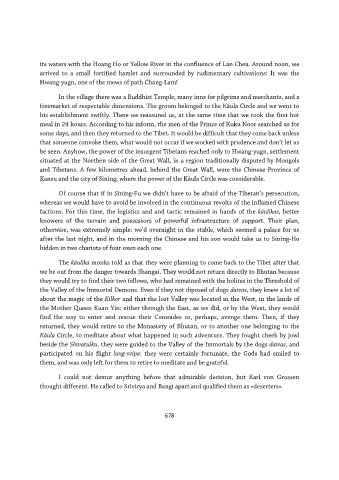Page 678 - Microsoft Word - Belicena respaldo
P. 678
its waters with the Hoang Ho or Yellow River in the confluence of Lan Cheu. Around noon, we
arrived to a small fortified hamlet and surrounded by rudimentary cultivations: It was the
Hwang-yugn, one of the mews of path Chang-Lam!
In the village there was a Buddhist Temple, many inns for pilgrims and merchants, and a
freemarket of respectable dimensions. The groom belonged to the Kâula Circle and we went to
his establishment swiftly. There we reassured us, at the same time that we took the first hot
meal in 24 hours. According to his inform, the men of the Prince of Kuku Noor searched us for
some days, and then they returned to the Tibet. It would be difficult that they come back unless
that someone convoke them, what would not occur if we worked with prudence and don’t let us
be seen. Anyhow, the power of the insurgent Tibetans reached only to Hwang-yugn, settlement
situated at the Northen side of the Great Wall, in a region traditionally disputed by Mongols
and Tibetans. A few kilometres ahead, behind the Great Wall, were the Chinese Province of
Kansu and the city of Sining, where the power of the Kâula Circle was considerable.
Of course that if in Sining-Fu we didn’t have to be afraid of the Tibetan’s persecution,
whereas we would have to avoid be involved in the continuous revolts of the inflamed Chinese
factions. For this time, the logistics and and tactic remained in hands of the kâulikas, better
knowers of the terrain and possessors of powerful infrastructure of support. Their plan,
otherwise, was extremely simple: we’d overnight in the stable, which seemed a palace for us
after the last night, and in the morning the Chinese and his son would take us to Sining-Ho
hidden in two chariots of four oxen each one.
The kâulika monks told as that they were planning to come back to the Tibet after that
we be out from the danger towards Shangai. They would not return directly to Bhutan because
they would try to find their two fellows, who had remained with the holites in the Threshold of
the Valley of the Immortal Demons. Even if they not diposed of dogs daivas, they knew a lot of
about the magic of the Kilkor and that the lost Valley was located in the West, in the lands of
the Mother Queen Kuan Yin: either through the East, as we did, or by the West, they would
find the way to enter and rescue their Comrades or, perhaps, avenge them. Then, if they
returned, they would retire to the Monastery of Bhutan, or to another one belonging to the
Kâula Circle, to meditate about what happened in such adventure. They fought cheek by jowl
beside the Shivatulku, they were guided to the Valley of the Immortals by the dogs daivas, and
participated on his flight lung-svipa: they were certainly fortunate, the Gods had smiled to
them, and was only left for them to retire to meditate and be grateful.
I could not demur anything before that admirable decision, but Karl von Grossen
thought different. He called to Srivirya and Bangi apart and qualified them as «deserters».
678

